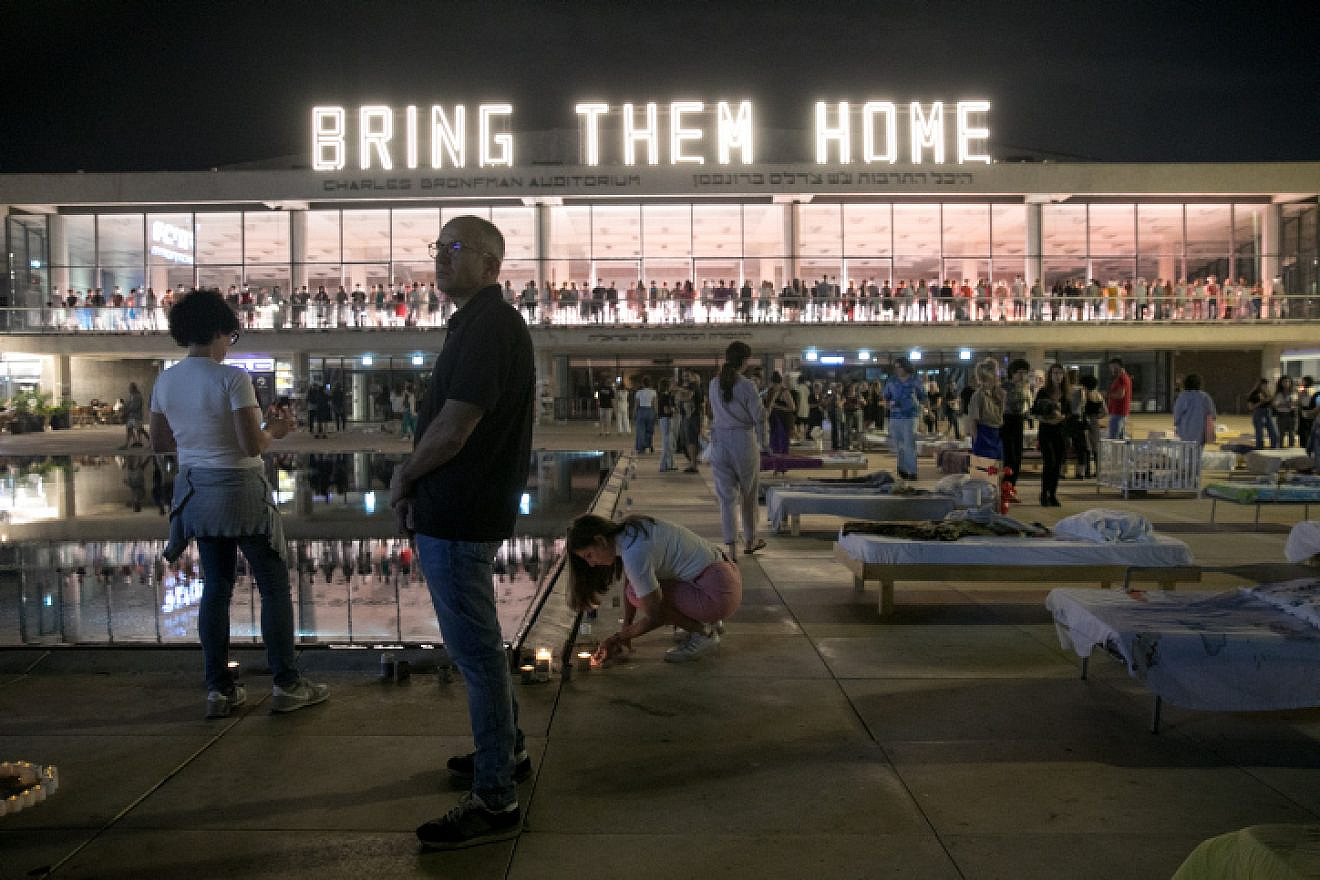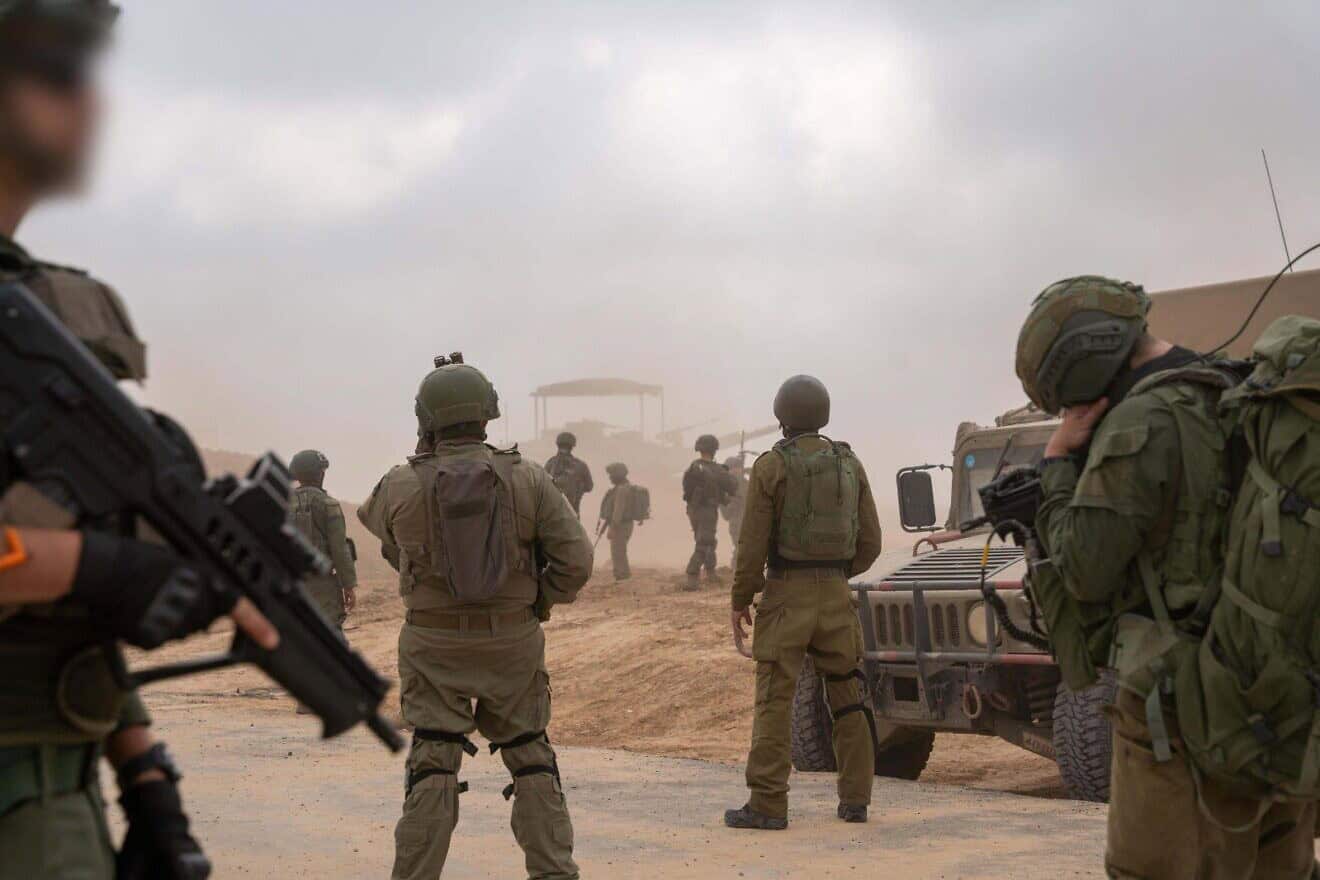Israelis walk by beds representing the number of hostages held captive by Hamas terrorists in Gaza, at Habimah Square in Tel Aviv, Nov. 11, 2023. Photo by Miriam Alster/Flash90.
By Noam Dvir
Hamas and other terrorist groups hold some 240 captives taken during the bloody atrocities of Oct. 7. As the IDF continues its operation in the Gaza Strip to defeat Hamas and free the hostages, their families have launched a campaign to get them released.
Prime Minister Benjamin Netanyahu has declared that the two goals of the operation are to bring the hostages home and to destroy Hamas. But what are the options for their release, and how long will it take? Below are the possibilities and the likelihood of each one occurring.
Intermediaries and a ceasefire
In recent days, various media outlets have reported different negotiations for the release of some of the captives in exchange for a ceasefire, but none has received confirmation from official Israeli sources. In any case, such a release wouldn’t resolve the captive issue. It might only increase pressure on the government.
According to Meir Ben Shabbat, head of the Jerusalem-based Misgav Institute for National Security and Zionist Strategy and a former head of Israel’s National Security Council, “in order to increase the chances of the captives’ return, it’s vital to increase military pressure in the Strip and simultaneously intensify pressure on the Qatari intermediaries.”
He adds, “The first component is being executed well. However, concerning the intermediary, it seems that both Israel and the international community have been treating Qatar with kid gloves. Qatar has been avoiding scrutiny even though it continues to provide shelter to Hamas and its leaders.”
Ben Shabbat argues that the way Israel deals with Qatar has not been effective because it has not pressured the Gulf state to act for the release of the captives.
“The intermediary exploits the situation to enhance its diplomatic status while being part of the problem. It’s time to demand that the U.S. set an ultimatum as follows: A swift release of the captives or else we will drastically change our policy towards Qatar, including revoking its special status, reducing economic, diplomatic and military ties, and imposing sanctions on entities supporting Hamas. It’s time to strip the intermediary of its hypocritical mask; trying to curry favor with it has not worked,” he says.
Pressures to release non-Israelis
About 120 of the captives hold non-Israeli citizenship, from 22 countries, divided into two groups: those who are dual Israeli citizens, and those who arrived in Israel as tourists or for work or study.
Nations whose nationals were taken—among them seven French citizens who are Israeli residents and many Thais who had been working in Israel—have already begun pressuring Hamas to bring about their release.
“Hamas is trying to achieve a ceasefire by releasing some of the captives,” Yaki Dayan, a former Israeli consul general in Los Angeles, says. “It cynically uses them and might want to select, isolate and differentiate between those without foreign citizenship and those who have it.
“Hamas wants to cater to some countries, like Russia. Because of shared interests, it’s possible that Israeli citizens with Russian citizenship might be released. If that happens, it’s not because Russia was acting to help Israel but due to its stand in favor of Hamas,” he adds.
“At the same time, countries like the U.S., France and Argentina are pressing for the release of their citizens. Ultimately, these are countries committed to their citizens. Beyond that, in the U.S., it has become a domestic issue that has affected politics and the public discourse.”
How effective are the levers?
“The most significant lever is Qatar. It’s not for nothing that the head of the Mossad visited there. However, there’s constant diplomatic dialogue on many fronts–American, French, Argentinean. Each country manages it separately, and from Israel’s perspective, it wants the release of all captives–it won’t volunteer to have only foreign-passport holders to be released,” Dayan says.
Prisoner exchanges
It might sound like a nightmare scenario where Israel releases terrorists with blood on their hands—including those involved in the atrocious massacre on Oct. 7—but one must also recall that Israel has in the past agreed to pay such a price.
In October 2011, an agreement was reached between the Netanyahu government and Hamas, mediated by Germany and Egypt. Under this agreement, Israel received the captured soldier Gilad Shalit in exchange for the release of 1,027 terrorists, among them Yahya Sinwar, currently the head of Hamas in Gaza.
In recent days, families of the captives have been campaigning for the release of their loved ones. Even if it’s not the official stance of the families, many of them demand the release of all the terrorists from Israeli prisons in exchange for all the captives.
However, the campaign leaders have since realized that the “everyone in exchange for everyone” campaign causes more harm than good.
In any case, it’s clear that Hamas won’t release all the captives without some form of ceasefire or a provision for the release of security prisoners held by Israel—thus, the question of the price that Israel will have to pay arises.
A military operation
Gaza is a city of terror. A densely populated place with many tunnels where Hamas terrorists hide. Yocheved Lifshitz, released from captivity on humanitarian grounds, recounted, “We walked kilometers inside a tunnel in Gaza.”
On the other hand, IDF Pvt. Ori Megidish, freed by the Israel Security Agency (Shin Bet) and the IDF, was held alone in an apartment in the Shati refugee camp, not far from Shifa Hospital in Gaza City—in other words, above ground.
Not all the captives are held in the same manner. Their release will demand multiple simultaneous military operations, all of which will pose a danger not only to the safety of the forces but also to that of the captives.
Various sources might say that “the military operation option is always on the table,” but practically speaking, Shalit spent five years in Gaza, and intelligence agencies didn’t manage to discover his whereabouts.
Furthermore, while Israel has an impressive record of rescuing hostages, there have been failures too. In October 1994, Sgt. Nachshon Wachsman was captured by Hamas and held north of Jerusalem. The end is known; he was murdered by the terrorists during an IDF attempt to rescue him, and with him died an officer from Sayeret Matkal, the elite General Staff Reconnaissance Unit, Capt. Nir Poraz.
A long line of former senior IDF officers have refused to publicly address the option of a rescue operation to bring the captives home. The issue is extremely sensitive and any statement about its chances of success or advisability will provoke reactions.
Humanitarian reasons
Last weekend, a video featuring captives Hannah Katzir, 77, and Yagil Yaakov, 13, was released by the Palestinian Islamic Jihad organization, claiming that they could be released for humanitarian reasons.
Yaakov suffers from allergies and is treated at the Allergy and Clinical Immunology Unit at Sheba Medical Center. The institute’s director asked international allergy organizations to appeal to the Red Cross to visit him and provide him with EpiPen injections—life-saving treatment for allergic children.
“The Red Cross has repeatedly failed,” Dayan says. “After they approached us regarding the detention conditions of Hamas terrorists, they did not meet with the Israeli captives.”
Source: JNS, originally published by Israel Hayom.


































